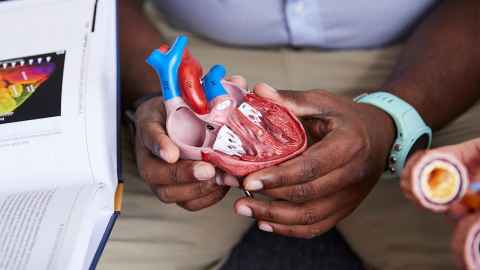Heart Mechanics
Delve into our research into heart mechanics.

The mechanical function of the heart is governed by the contractility of the cells, the properties and microscopic architecture of the tissues, and the anatomical geometry, blood pressure and volume loading of the heart.
The performance of the heart is fundamentally dependent upon its metabolism. Reduced blood supply to the heart (ischaemia) compromises its metabolism and hence function, and is the main cause of mortality in the developed world.
Our teams integrate novel instrumentation, experimental models and multi-scale computational methods to understand the fundamental links between structure, properties, mechanics and metabolism of the heart in order to better understand the mechanisms that underpin heart function in health and disease.
The groups are also using their sophisticated 3D heart modelling capability to develop educational software that describes how the heart works, and common problems of the heart.
Research areas
Understanding mechanical function of the heart
Mathematical models of the anatomy, tissue architecture and mechanical properties of the heart are being developed to represent normal and pathological mechanical processes. The muscular wall of the heart has a complex layered, fibrous 3D architecture that has a profound effect on its mechanical behaviour.
Mathematical models of the anatomy, tissue architecture and mechanical properties of the heart are being developed to represent normal and pathological mechanical processes. The muscular wall of the heart has a complex layered, fibrous 3D architecture that has a profound effect on its mechanical behaviour.
These models and measurements are amalgamated using multi-scale integrative computer analysis techniques, and being used to improve our fundamental understanding of the biophysical mechanisms that relate structure and mechanical function of the heart.
Understanding the effect of metabolism on mechanical and electrical properties of heart cells
Altered metabolism produces many changes to the mechanical and electrical properties of heart cells. Despite extensive experimental studies, the complicated sequence of events leading from the initial trigger, such as the blockage of a coronary artery, to life-threatening pump failure remains poorly understood.
We use theoretical, mathematical and experimental techniques to study this complex cardiac function. We have developed unique devices to simultaneously measure multiple biomarkers, such as calcium, myofilament deformation, heat production, force and shortening, of cardiac muscle. We interpret these experimental recordings within biophysically based mathematical models of cardiac bioenergetics to characterise the effects of compromised metabolism during ischaemic events.
We use theoretical, mathematical and experimental techniques to study this complex cardiac function. We have developed unique devices to simultaneously measure multiple biomarkers, such as calcium, myofilament deformation, heat production, force and shortening, of cardiac muscle. We interpret these experimental recordings within biophysically based mathematical models of cardiac bioenergetics to characterise the effects of compromised metabolism during ischaemic events.
Improved diagnosis of heart diseases
Clinical studies are underway to translate our quantitative understanding of heart function, and the tools and techniques we have developed through our fundamental research studies, to characterise the properties and function of hearts of patients in the clinical setting.
These techniques will enable improved diagnosis of cardiac diseases and evaluation of treatments.
Multi-scale and multi-physics models of the heart, validated against clinical and experimental recordings (from MRI, ultrasound, etc), can be used to provide regional estimates of myocardial properties, such as contractility, stiffness, relaxation, wall stress, and energy demand. Quantitative biomarkers of this kind can be used to identify specific mechanisms of heart disease for individual patients.
Funding Partners
The cardiac mechanics and metabolism research teams gratefully acknowledge the support of its funding partners: